Page 39 of 40
Re: jackz432r
Posted: Tue May 07, 2019 10:06 pm
by Wurzel
Careful Paul your Whitter searching isn't supposed to be bad for your health


I like your handy way of spotting larva without the need for a ladder

Have a goodun
Wurzel
Re: jackz432r
Posted: Wed May 08, 2019 5:47 pm
by Pauline
I think your research and findings has shown quite clearly Paul that the WLH is not just under recorded, it is MASSIVELY under recorded. I think you're also probably doing a fine job educating folk and I include myself in that. Thanks for the details you sent me recently. If I check it out I'll let you know. In the meantime keep up the good work.

Re: jackz432r
Posted: Thu May 09, 2019 8:33 am
by David M
Great tutorial, Paul. Very helpful. It’s interesting to see the pattern of feeding and as you say, with elm leaves now unfurled, this is the best time to go looking.
Re: jackz432r
Posted: Sun May 12, 2019 10:03 pm
by Paul Harfield
Re: jackz432r
Posted: Mon May 13, 2019 5:28 pm
by Wurzel
That is a cracking Duke - a great reward for all the hard searching - I swear that Butterflies have an innate telepathic capability


I often find pouring a coffee or having a mouthful of my extra hot Lime Chilli Pickle has the same affect

Have a goodun
Wurzel
Re: jackz432r
Posted: Mon May 13, 2019 10:31 pm
by David M
Paul Harfield wrote:...I come here specifically for Pearl Bordered Fritillary. My visit this year was better timed than previously catching some fresher individuals than I have done in the past. The weather also was ideal for capturing this species, cloudy and cool with short spells of warm sunshine.
Yes, Paul, cloudier, cooler conditions are better for this species. Their flight season coincides with quite a spectrum of potential weather, but hot sunny days are not ideal.
Congratulations for the Common Blue. They seem rather shy this year!

Re: jackz432r
Posted: Tue May 14, 2019 10:01 pm
by Paul Harfield
Re: jackz432r
Posted: Mon May 20, 2019 9:12 pm
by Paul Harfield
Re: jackz432r
Posted: Mon May 20, 2019 10:22 pm
by Wurzel
Interesting report Paul - I'm wondering which strategy will work best and what agents will do the testing

The chamber is the most hidden but then birds could learn that there's a tasty morsel hidden away in between the leaves so it could almost be an advertisement

Great work.
Have a goodun
Wurzel
Re: jackz432r
Posted: Tue May 21, 2019 3:40 pm
by David M
It really is a superb skill you have, Paul, being able to locate them at this stage. Thanks again for increasing our knowledge of this species.
Re: jackz432r
Posted: Wed Jun 05, 2019 10:14 pm
by Paul Harfield
Thanks for the comments Wurzel & David

More recent doings..
In The Garden
A significant event in my garden this year is that my Buddleia globosa has flowered for the first time. I have spent several years unknowingly pruning it in completely the wrong way

and wondering why it never flowers. I now know what I should be doing and have been rewarded with a generous show

. It has also attracted the attention of several other admirers.
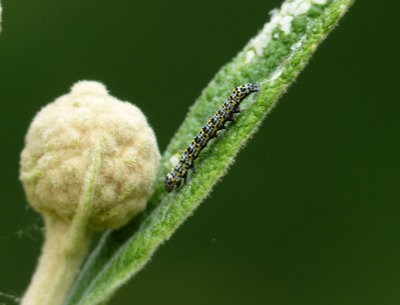
- 18.5.2019 - Buddleia globosa leaves have been a firm favourite with the Mullein moth larvae over the last few years.
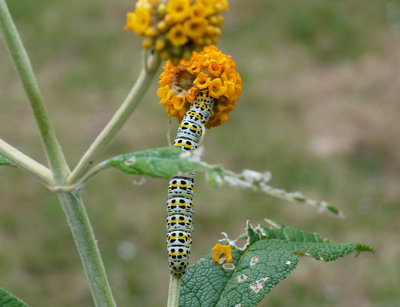
- 5.6.2019 - A couple of weeks on and the same larva is now getting stuck in to the flowers.... literally
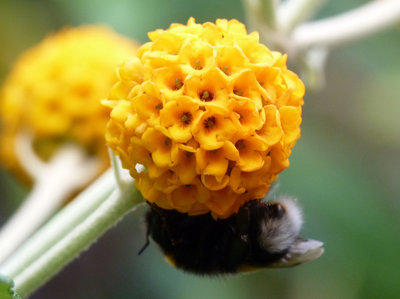
- 5.6.2019 - Tonight this bee seems to have fallen asleep whilst indulging in globosa nectar!
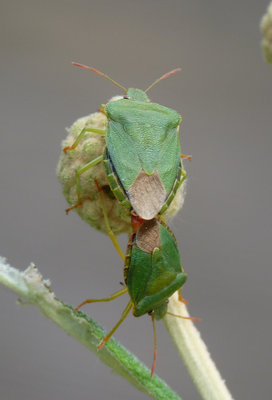
- 27.5.2019 - These amorous shield bugs spent several days gorging on the unopened flower buds
White-Letter Hairstreak
I was recently invited to a private site to look for White-Letter Hairstreak larvae. On 25th May I accompanied Andrew Brookes (Hants & IOW BC species champion for the White-Letter Hairstreak) to the site where he had planted Elms of various types and cultivars 20 years ago (as trials for DED resistance). To date no evidence of the butterfly had previously been found at this site. I was initially doubtful of finding larvae due to the timing of our visit, I suggested we were perhaps a week too late. However, there was plenty of feeding damage evident on various trees particularly a White Elm (Ulmus laevis). After an hours searching I managed to locate a single White-Letter Hairstreak larva on a Japanese Elm (Ulmus davidiana var.japonica). This was a magical moment.
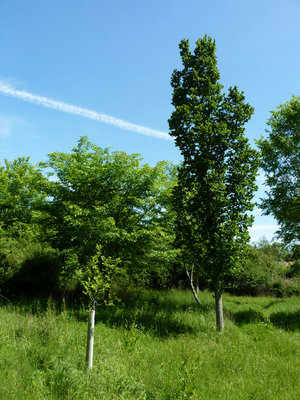
- 1.6.2019 - Ulmus davidiana var. japonica and 'columnella' just 2 of many varieties of Elm at a private site in Hampshire.
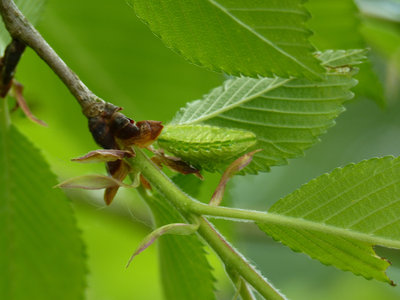
- 25.5.2019 - White-Letter Hairstreak larva on Japanese Elm (Ulmus davidiana var. japonica)
He then suggested we visit another site not too far away where further Elms had been planted 10yrs ago. Again White-Letter Hairstreak had not been recorded there thus far. This site is a rather more exposed location but I managed to locate a pupa on provence Field Elm on this years growth. Unfortunately the pupa had been predated but nevertheless proving that the butterfly has reached both locations.
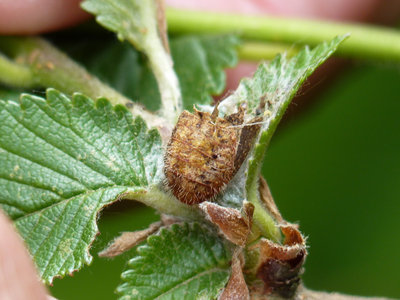
- 25.5.2019 - Predated White-Letter Hairstreak pupa
Meanwhile at home I patiently await the imminent emergence of White-Letter Hairstreak from x2 rescued larvae.
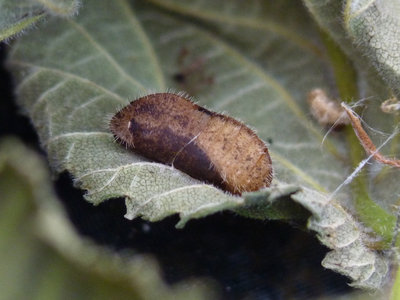
- 27.5.2019 - White-Letter Hairstreak pupa
Re: jackz432r
Posted: Thu Jun 06, 2019 9:38 pm
by David M
Great observations, Paul. The clock is now ticking for WLH emergence. I expect the first to be around the weekend after next.
Re: jackz432r
Posted: Sat Jun 08, 2019 4:26 pm
by Paul Harfield
David M wrote:Great observations, Paul. The clock is now ticking for WLH emergence. I expect the first to be around the weekend after next.
Thanks David

- Last year the earliest record down here in Hampshire was 2nd June and in 2017 it was 9th June I think. If I can find a gap in the weather I had my fingers crossed for some action this weekend. Nothing doing today though, it is all a bit wet,windy and unpredictable

.
Last year Pauline and I had some discussion about pupation habits of the White-Letter Hairstreak and the possibility that they do in fact pupate in leaf litter in the ground. This is contrary to most British references about the pupation of this species. I was recently shown this video
https://www.youtube.com/watch?v=vdDNGF2HDr0 the most interesting bit is at the end.
Interestingly, it only refers to pupation on the ground for this species with no mention of leaves or twigs as a chosen position for pupation. It was recorded in southern France. Could this be something driven by climate/temperature ie the hotter it is the more likelihood that the larva will go to the ground to pupate? Any comments are welcome.
Re: jackz432r
Posted: Sat Jun 08, 2019 4:44 pm
by Pauline
Hi Paul, what we need is irrefutable proof that they pupate in leaf litter (when not captive reared). I have been doing my bit and I know you have too. Great video which goes a long way to support our views. It is quite possible that the variation in choices of pupal location are part of a transitional phase which could be down to climate change or something else. I'll keep in touch tho it may now be a bit late for this year.
Re: jackz432r
Posted: Sun Jun 09, 2019 5:29 pm
by David M
Paul Harfield wrote:..Last year Pauline and I had some discussion about pupation habits of the White-Letter Hairstreak and the possibility that they do in fact pupate in leaf litter in the ground. This is contrary to most British references about the pupation of this species. I was recently shown this video
https://www.youtube.com/watch?v=vdDNGF2HDr0 the most interesting bit is at the end.
Interestingly, it only refers to pupation on the ground for this species with no mention of leaves or twigs as a chosen position for pupation. It was recorded in southern France. Could this be something driven by climate/temperature ie the hotter it is the more likelihood that the larva will go to the ground to pupate? Any comments are welcome.
Those VarWild films are as good as anything I've ever seen. Thanks for highlighting this one, Paul, as I hadn't hitherto seen it.
Like you say, the most interesting bit is near the end, when the butterfly emerges from the pupa within the leaf litter.
Re: jackz432r
Posted: Tue Jun 11, 2019 9:09 pm
by Paul Harfield
Sunday 9.6.2019 IBM/Lakeside Cosham
This site is always reliable at providing my earliest White-Letter Hairstreak sightings, but it has become less user friendly over the last few years. However, they have now mown/cleared a wide walkway through the grass and trees which has restored access to the best area. When I arrived, just after lunch, the sun was frustratingly hidden behind cloud despite half the sky being blue.
The first thing that caught my eye during the cloudy spell was my first Marbled White of the year. There was not much else going on but I had a feeling that my target was there just waiting for some sun. A few Meadow Browns stirred and a beautiful blue female Common Blue posed nicely as well as few other inhabitants.
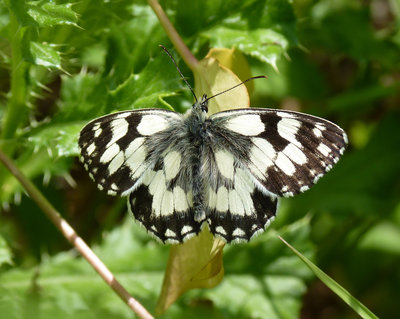
- My first Marbled White of the year
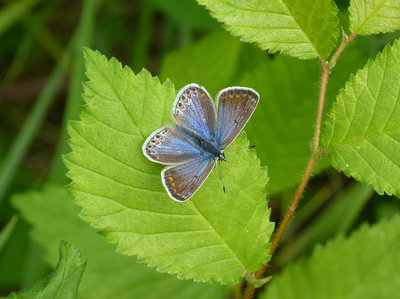
- Female Common Blue
After waiting an hour and a half for the sun to reappear I was eventually rewarded with a single White-Letter Hairstreak

. This moment marks the beginning of an intense few weeks following this species around Hampshire.
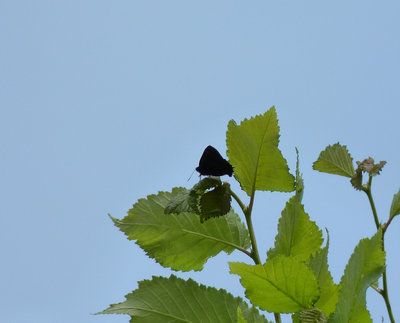
- A distant shot of my target which did eventually appear during a period of prolonged sunshine
Re: jackz432r
Posted: Tue Jun 11, 2019 9:36 pm
by Padfield
What is the creature on the leaf below the adult hairstreak, Paul? It looks very like a w-album cat, though it seems to be on the upperside of the leaf.
Guy
Re: jackz432r
Posted: Wed Jun 12, 2019 10:09 pm
by Wurzel
A great find Paul

- is that the first in the UK this year?

It's been a few years since I've been to Cosham - I've been keeping half an eye on the Bentley Whitters - if only I had more time I'd like to get there again

Have a goodun
Wurzel
Re: jackz432r
Posted: Wed Jun 12, 2019 10:14 pm
by Paul Harfield
Padfield wrote:What is the creature on the leaf below the adult hairstreak, Paul? It looks very like a w-album cat, though it seems to be on the upperside of the leaf.
Guy
Hi Guy
To be honest I had not noticed it, this was a long range and highly cropped shot. I would have thought it was unlikely to be a WLH larva, but it is possible I suppose. Or maybe a gall of some description or other leaf blemish, we will never know.
Re: jackz432r
Posted: Thu Jun 13, 2019 8:11 am
by peterc
Wurzel wrote:A great find Paul

- is that the first in the UK this year?

It's been a few years since I've been to Cosham - I've been keeping half an eye on the Bentley Whitters - if only I had more time I'd like to get there again

Have a goodun
Wurzel
HI Wurzel,
A White-letter was reported from Durant's Park, Enfield on Saturday 8 June and another one from Sussex on the same day.
ATB
Peter

 I like your handy way of spotting larva without the need for a ladder
I like your handy way of spotting larva without the need for a ladder 